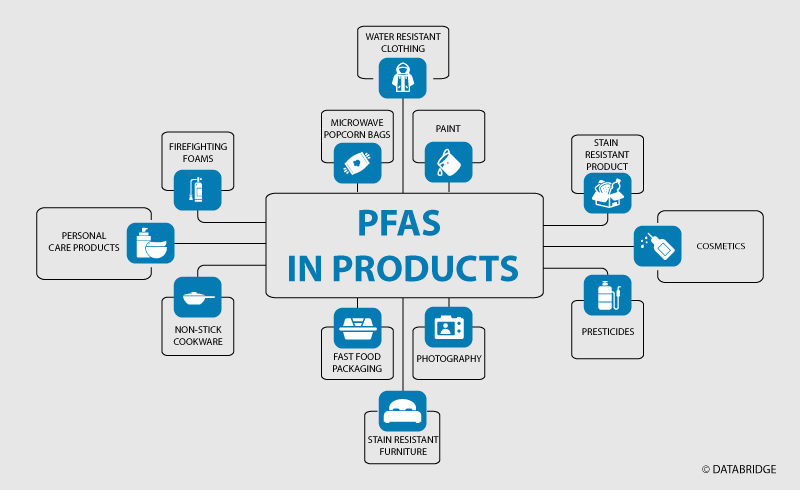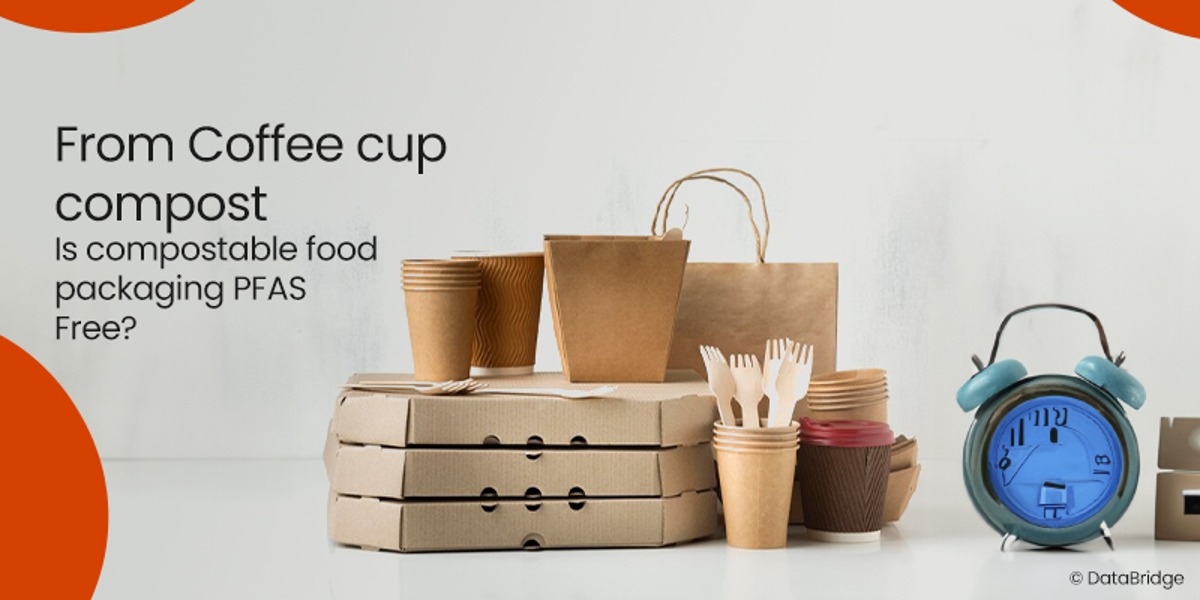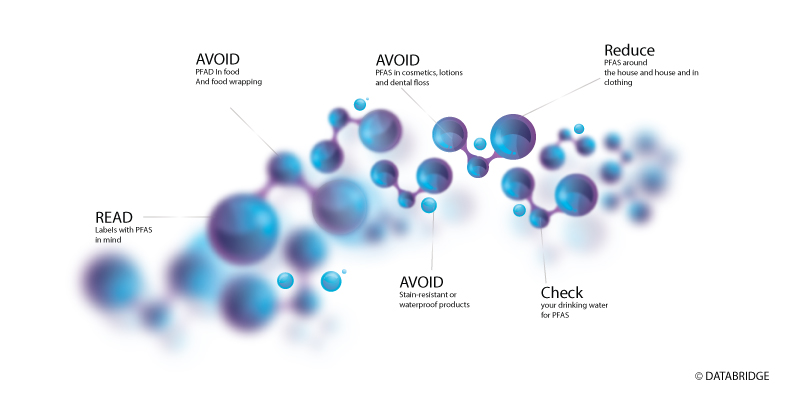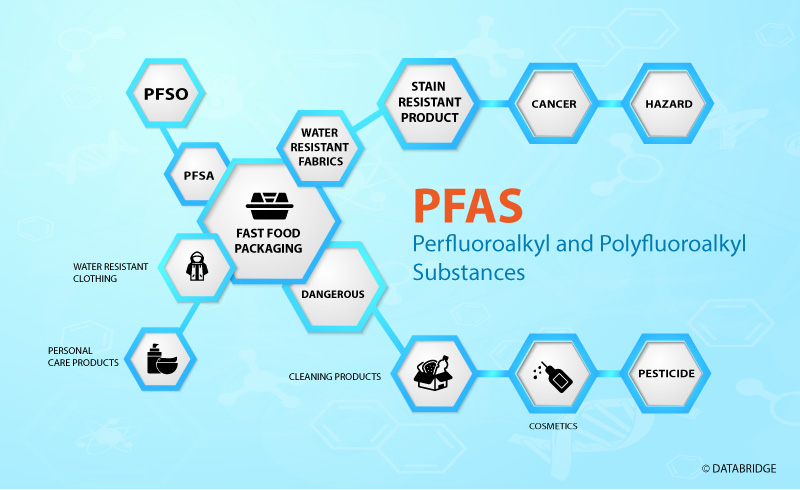Introduction
Per- and polyfluoroalkyl substances (PFAS) constitute a large family of fluorinated chemicals that vary widely in their chemical and physical properties. The number of PFAS and their uses has expanded over the years. In 2020, as per a report by the United States Environmental Protection Agency (USEPA), it has been estimated that the PFAS family may include more than 12,000 chemical substances.
Since the 1950s, many products commonly used by consumers and industry have been manufactured with or from PFAS. The unique physical and chemical properties of PFAS impart oil, water, stain, and soil repellency, chemical and thermal stability, and/or friction reduction to a range of products. These products have applications in various industries including aerospace, semiconductor, medical, automotive, construction, electronics, and aviation industries, as well as in consumer products (such as carpets, clothing, furniture, outdoor equipment, and food packaging among others), and firefighting applications.
Scientific, regulatory, and public concerns have emerged about potential health and environmental impacts associated with chemical production, product manufacture and use, and disposal of PFAS-containing wastes. These concerns have led to efforts to reduce the use of or replace certain PFAS, such as certain long-chain perfluoroalkyl carboxylates, long-chain perfluoroalkane sulfonates, and their precursors, including two widely produced, commonly encountered, and most studied compounds: perfluorooctane sulfonic acid (PFOS) and perfluorooctanoic acid (PFOA).
PFAS are used in a variety of manufacturing processes and industrial/commercial applications to create commercial and consumer products that contain or are treated with PFAS. Throughout this life cycle, variable types and amounts of PFAS may be released to the environment from manufacturing waste streams, fugitive emissions, spills, disposal of PFAS-containing or treated materials, and general wear and tear of consumer products.
Data Bridge Market Research analyses that the high performance fluoropolymer market will witness a CAGR of 7.50% for the forecast period of 2022-2029. Growth in the demand for high performance fluoropolymer especially in emerging economies such as India and China, and the growing use of high performance fluoropolymer for a wide range of end-user applications are the major factors attributable to the growth of the high performance fluoropolymer market.
To know more about the study, visit: https://www.databridgemarketresearch.com/reports/global-high-performance-fluoropolymer-market

PFAS-Free Compostable Products
Polyfluoroalkyl substances (PFAs) are a group of human-made chemicals used in a variety of products for their water- and grease-resistant properties. PFAS have been produced on a commercial scale since the 1950s, and production continues today. PFAs have raised environmental and health concerns due to their persistence in the environment and potential adverse effects on human health. PFAs-free compostable products, on the other hand, are designed to break down into natural and non-toxic components under specific conditions, typically in a composting environment.
As companies abandon PFAS-containing materials in food packaging amid pressure on multiple fronts, a new landscape of alternatives is emerging. Since the 1960s, the Food and Drug Administration (FDA) has authorized specific PFAS for use in specific food contact applications. Some PFAS are used in cookware, food packaging, and in food processing for their non-stick and grease, oil, and water-resistant properties. To ensure food contact substances are safe for their intended use, the FDA conducts a rigorous scientific review before they are authorized for the market. FAS are often used in food packaging to make materials more durable and resistant to stains and water. However, these chemicals have been linked to a range of health problems.
Taking in consideration these health effects, various manufacturers are developing PFAS-free products such as fiber and paper food packaging, which has no added PFAS and is compliant with the strictest composting standards. These products are BPI Certified Compostable, CMA Certified Compostable, or OK Compost TUV Austria Certified and cannot contain intentionally added PFAS to become certified. Some of these include PLA, PHA, bamboo, cellophane, paper, and NoTree paper packaging items.
Good Start Packaging offers various packaging for food industry that are PFAS-free. These products are compliant with the packaging bans in California, New York, Washington, and Vermont.
A trace amount of PFAS is approved by the FDA for use in packaging products as a grease-resistant additive. This is being phased out by the industry as various U.S. states and other regions have begun to ban them. Therefore, single-use disposable food packaging and service ware are available without PFAS, including uncoated paper products, products made with materials other than paper, and paper products treated with coatings other than PFAS.
Below is a description of some compostable PFAS-free alternatives and associated manufacturers and brands:
- Uncoated Products: An alternate mechanical process can make paper and paperboard grease-resistant by compressing the fibers currently made by Nordic Paper. Another manufacturer of uncoated paper plates is AJM Packaging Corporation
- Polylactic Acid (PLA) is a compostable plastic typically made from corn made by several manufacturers including Natureworks under the Ingeo brand and used by Eco-Products, Greensafe Products, GrowPlastics, and World Centric. These products include bowls, clamshells, take-out containers and lids, deli containers, cutlery, and portion cups
- Bamboo-Bambu manufactures disposable plates and bowls from thin sheets of bamboo
- Palm Leaf produced by Responsible and by BioMass Packaging under the Leafware brand
- Alternative Treatments: Paper coated with PLA, silicone, clay, and other proprietary-branded coatings and treatments are used to impart oil and grease resistance to disposable food service ware
- PLA coated paperboard soup bowls and take-out containers have been produced by: Practiv’s Earthchoice, Graphic Packaging International’s Ecotainer, Eco-Products World Art, PrimeLink Solutions’ PrimeWare, Karat, Vegware, and World Centric
- Bio-wax-Bio-based wax coatings are produced by Clondakin Group under the Ecowax brand and by Paramelt under the Paraflex NoWax brand for a variety of food contact applications including bags, wraps, and boxes
Manufacturers are responding to the market demand for fluorine-free compostable food service ware products from large purchasers such as academic institutions, state governments, the education sector, and health care systems. Manufacturers are actively working on non-fluorinated alternatives and new products are expected to be on the market within the coming year.
The compostable food service packaging market is expected to gain market growth in the forecast period of 2022 to 2029. Data Bridge Market Research analyses the market to grow at a CAGR of 5.70% in the above-mentioned forecast period.
To know more about the study, visit: https://www.databridgemarketresearch.com/reports/global-compostable-foodservice-packaging-market

International Standards Compliance for PFAs-based products
- In the 2000s, various pieces of evidence linking the chemicals to an increased risk of some cancers, reproductive and developmental abnormalities, a suppressed immune response, and other issues led the U.S. Food and Drug Administration (FDA) to revoke authorization for long-chain PFAS, which was the oldest and most common type in food packaging.
- In recent years, about two dozen states, from Washington to North Carolina, have either banned or restricted PFAS in food packaging or are considering doing so. Pressure from health and environmental advocates, as well as some scientists, has also spurred restaurant chains, grocery stores, and packaging companies to make the switch. Moreover, states and countries around the world are managing PFAS in multiple ways: limiting or removing their usage in common source material, establishing testing and reporting requirements, and directing and funding repair.
Europe
- At the European level, major authorities took the first step toward monitoring PFAS contamination in 2004. In fact, in 2004, the European Union published a regulation of the production and commercialization of PFOS that was valid until 2019. That legal document for regulation was replaced by the “Regulation (EU) 2019/1021 of the European Parliament and of the Council of 20 June 2019 on persistent organic pollutants”, where the manufacturing, use, and placing on the market of substances listed in Annex I, such as PFOS and its derivatives C8F17SO2X (X = OH, metal salt (O-M+), halide, amide, and other derivatives including polymers, in mixtures or in articles, shall be prohibited with some exemptions
- The Norwegian Environment Agency, in 2019, submitted a proposal to list PFHxS (with its salts) and PFHxS-related compounds in Annexes A, B, and/or C to the Stockholm Convention on POPs.
- Denmark, Germany, the Netherlands, Norway, and Sweden took the most significant step in the fight against per- and polyfluoroalkyl substance contamination in Europe when they submitted a proposal to ECHA to prohibit PFAS under REACH. The five authorities found risks related to the manufacture, marketing, and use of the contaminants that are not properly controlled and need to be addressed by the EU and EEA (European Economic Area)
U.S.
- In the United States, state legislatures and the federal government are taking actions to protect the environment (water, soil) and public health. The U.S. EPA, after the publication in 2016 of a non-enforceable health advisory on PFOA and PFOS, unveiled a formal PFAS Action Plan in 2019, then updated it in February 2020
- In October 2021, EPA announced the Agency’s PFAS Strategic Roadmap, which represents an important and meaningful step to safeguard communities from PFAS contamination, providing a more enduring and protective solution
- In March 2023, the EPA moved forward with the development of a national drinking water regulation to establish maximum contaminant levels (MCLs) for 6 PFAS: PFOA, PFOS, PFNA, GenX compounds, PFHxS, and perfluorobutane sulfonic acid (PFBS)
- From 2018 to 2021, lawmakers enacted more than 250 PFAS-related bills to regulate their use of several materials and set maximum levels of contamination. More than 200 measures with PFAS-related terminology were discussed by legislators in 2022, and approximately 50 bills on PFAS in food packaging, firefighter personal protective equipment, and environmental remediation were passed in at least 18 states. The issue of PFAS in consumer items such as apparel, children’s goods, cookware, furniture, cosmetics, and ski wax was also brought up by lawmakers in their legislation
Canada
- In 2021, the Canadian Council of Ministers of the Environment (CCME) issued soil and groundwater guidelines for PFOS. In spring 2021, Canada proclaimed the intention to consider PFAS as a class, rather than individual compounds
Asia-Pacific Countries
- The Asian nations are attempting to tighten their laws. In Japan, in April 2021, PFOA was added to the list of Class I Specified Chemical Substances under the CSCA, while the PFOA-related substances were not
- In China, in November 2020, 18 compounds, PFOA included, were put on the list of Priority Control Chemicals, and this is a starting point for the laws and legislation to take measures on the environmental risk control. On 11 October 2021, China’s Ministry of Ecology and Environment released a draft planning to manage new pollutants including PFOA more effectively
- In Taiwan, the government amended the regulation on toxic chemical substances in September 2020, changing the handling volume by grade and toxicity classification of PFOA
- In Thailand, in May 2021, eight molecules, including PFOA, were proposed as Class 4 prohibited substances. On 9 February 2022, the Department of Industrial Works, Ministry of Industry of Thailand opened a new draft on PFOA regulations, on 21 December 2022 adding PFOA, its salts, and PFOA-related compounds into the hazardous substances list
- In Vietnam, for the first time, the Law on Environmental Protection of 2020 specifically mentions the Stockholm Convention. One of its subordinate laws, the draft decree, lists PFOA as a substance to be regulated. Later, in November 2021, the Law on Environmental Protection set allowable limits of POPs including PFOA
- In Australia, in February 2019, an Intergovernmental Agreement came into effect to face PFAS contamination
Applications of PFAs in Various Industries
The use of fluorinated organic compounds (PFAS) is widespread across various industrial and domestic applications including for textiles, food packaging, stain and oil resistant treatments, industrial processes and firefighting foam.
Per- and polyfluoroalkyl substances (PFAS) have been used in firefighting foams. These foams have been used in fire suppression activities, especially for fighting flammable liquid fires, such as those involving petroleum-based products. PFAS-containing foams have been widely used at military bases, airports, and other locations where the risk of large-scale fuel fires exists. These fluorine-containing foams are commonly referred to as AFFF (aqueous film-forming foam) but also include FFFP and FP fluoroprotein foams. The alternatives to AFFF are Class B fluorine-free, non-persistent firefighting foams (F3); this technology is not new but has advanced considerably over the last 5-10 years since the realization of problems associated with PFAS.
- In packaging industry, brands are expanding sustainability strategies to include clean packaging with the lowest levels of PFAS or other chemicals of concern possible. Since global legislation varies, global brands are aligning to strict legislations. This also ensures there is safe disposal of packaging in form of recycling, reuse, repurpose, composting, incineration in waste-to-energy and related systems, or landfilled. This ensures a safe supply of recycled and reusable packaging
- PFAS-free compostable materials are explored in the textile industry for the production of sustainable fabrics and clothing. Biodegradable textiles made from plant-based sources are gaining popularity as an alternative to conventional, less sustainable materials
- Compostable materials are finding applications in automotive interiors, including panels and components. In the defense sector, where environmental impact is a concern, the use of PFAS-free compostable materials may be explored for certain non-critical components
- Various consumer goods, such as toiletries, cosmetics, and household products, use PFAS-free compostable packaging to align with consumer preferences for sustainable and environmentally friendly options
The versatility of PFAS-free compostable products allows them to be integrated into a wide range of industries, contributing to the reduction of environmental pollution and promoting more sustainable practices across different sectors.

Challenges and Solutions in Adopting PFAS-Free Compostable Products
Fluorinated surfactants and additives are typically sold on the market at a higher price point than their non-fluorinated counterparts. However, the lower use concentrations of the PFAS-based ingredients offsets the higher price and is a more economical option for high performance across a breadth of industries and applications. The cost implications of substituting PFAS often presents a barrier to those seeking to reformulate. Ultimately, the price differential is a critical factor when it comes to valuating the competitiveness of non-fluorinated alternatives across a variety of applications.
For instance,
- in firefighting foam applications, non-fluorinated alternatives were consistently 5%–10% more expensive to achieve comparable performance as PFAS formulations. In paper and board food packaging applications, adoption of non-fluorinated alternatives is hindered by a finished cost of 11% more compared to PFAS options. In architectural coating applications, initially, the polyurethane alternatives typically cost 26% less compared to PFAS-based coatings.
Regulatory Factors
Legislation that is directly or indirectly relevant to PFAS plays a role in the current environment surrounding PFAS substitution. For instance, the coatings industry has historically used PFAS as a wetting agent to provide leveling and spreading properties that consumers expect from quality coatings. In recent years, the coatings industry has been shifting to water-borne systems to reduce volatile organic compounds as a result of regulatory restrictions. This puts increased demand on coatings as water has a higher surface tension than organic coating solvents, and therefore wetting of substrates becomes a major challenge. At the same time, regulatory bodies are restricting the use of PFAS, which has been relied upon to address this deficit. However, some industries face challenges in eliminating PFAS, regulation can be a driver for innovation and progress.
Performance
The main challenges of finding PFAS alternatives in packaging is identifying alternatives that are viable, scalable, and safer than PFAS. In some applications, PFAS can be readily substituted with minimal impact on perceived performance, but for others such as non-stick cookware, water-repellent clothing, and surface coatings, the standard for performance expected by consumers makes PFAS not as easily replaced. This has become a major barrier to substitution for many product developers because they face the challenge of impending legislation and consumer backlash alongside the need to maintain strong performance. When considering substitution of PFAS, various performance factors must be considered and evaluated. PFAS are also known for their ability to withstand harsh conditions, such as high temperatures, chemicals, and abrasion. Thus, when replacing PFAS, it is vital to ensure that the alternative material or coating can provide similar durability under the intended conditions of use. This requires careful consideration of the mechanical, thermal, and chemical properties of the alternative material or coating.
Case Studies
Despite the functionality and usefulness of PFAS, demand is growing for alternatives that offer similar or better performance without the negative environmental and health impacts. Substitution of PFAS in new and existing products can be complicated and depends on various factors. PFAS provide high performance in various functions at very low concentrations and at highly economical costs, which has ultimately driven adoption and proliferation across several industries. When considering potential substitutes for PFAS, product developers and formulators are considering not only the price implications of alternative chemistries, but also the regulatory landscape surrounding substitutes, and therefore, are launching new products.
For Instance,
- In April 2023, Delfort developed a range of PFAS-free food packaging papers that are sustainable, safe, and highly functional. The Company’s iconic thin barrier eco range is the perfect solution for wrapping on-the-go food like burgers, wraps, fries, chicken nuggets and hashbrowns. They are also suitable for bakery items such as cookies and donuts
- U.S. manufacturers have developed numerous PFAS to replace long-chain PFAS such as PFOA, PFOS, and perfluorononanoic acid (PFNA). One case is hexafluoropropylene oxide dimer acid (HFPO-DA) and the HFPO-DA ammonium salt, the two chemical substances that are part of the GenX technology developed by Chemours (formerly DuPont), that were developed as a PFOA replacement. These replacement chemicals are part of the larger suite of more than 9,0006 PFAS, some of which the EPA has approved for manufacture and use in the U.S.
- The food service and retail sectors are making an impact. More than 14 key players such as Burger King, McDonald’s, and Panera Bread are building sustainability strategies around PFAS initiatives. Notably, Panera Bread launched PFAS-free baguette bags in the summer of 2020. Four large U.S. grocery chains now require PFAS-free packaging on private labels.
Data Bridge Market Research analyses that the green food packaging market which was growing at a value of 311.7 billion in 2021 and is expected to reach the value of USD 692.84 billion by 2029, at a CAGR of 10.50% during the forecast period.
To know more about the study, visit: https://www.databridgemarketresearch.com/reports/global-green-food-packaging-market
Future Outlook
PFAS and PFAS contamination are nowadays an important issue that interest all levels of society, from scientific communities to citizens. Worldwide, authorities are actively and constantly working on legislation to reduce the release of PFASs into the environment, while waiting for expert opinions from the scientific community on the levels of actual contamination.
Researchers are addressing this topic from different points of view, including toxicological studies and advances in analytical methods for the detection of PFAS traces in real matrices. Groundwater and food are known to be the most common sources of contamination for humans, and drinking water and plant-based foods are currently under deeper investigation. Improving untargeted analysis of perfluorinated compounds is an important step toward an exhaustive comprehension of the possible risk posed by PFAS to the environment and human health. The future outlook for PFAS-free compostable products appears promising, driven by increasing awareness of environmental issues, sustainability goals, and regulatory pressures.
Growing Consumer Awareness
As environmental consciousness rises, consumers are actively seeking sustainable alternatives. The demand for products free from harmful substances like PFAS, coupled with compostability, is likely to increase. Brands that communicate their commitment to eco-friendly practices may gain a competitive edge.
Regulatory Initiatives
Governments and regulatory bodies are increasingly focusing on limiting the use of harmful substances and promoting sustainable practices. Stricter regulations regarding PFAS and single-use plastics may drive industries to adopt PFAS-free compostable alternatives. Companies that proactively comply with evolving standards will be better positioned in the market.
Advancements in Material Science and Technology
Ongoing research and development in material science are likely to yield innovative and more sustainable alternatives. Manufacturers may explore new biodegradable materials, improving the performance, durability, and versatility of PFAS-free compostable products. Advancements in manufacturing technologies can enhance the efficiency and cost-effectiveness of producing PFAS-free compostable products. Continuous improvement in production processes may contribute to wider adoption and affordability.
Consumer Education and Labeling
Increased efforts in educating consumers about the benefits and proper disposal methods of PFAS-free compostable products will be essential. Clear labeling and certification standards can help consumers make informed choices, further driving demand. PFAS-free compostable products are likely to expand beyond traditional sectors like packaging into industries such as textiles, electronics, and more. This diversification will contribute to a broader adoption of sustainable practices across various markets.

Conclusion
In conclusion, the emergence of PFAS-free compostable products stands as a pivotal response to the global imperative for sustainable and eco-friendly alternatives across diverse industries. The journey from conventional materials laden with per- and polyfluoroalkyl substances (PFAS) to the development and acceptance of compostable alternatives has marked a significant stride toward environmental responsibility. The multifaceted applications spanning food packaging, cookware, metal, automotive and defense, pharmaceutical and engineering, underscore the versatility and adaptability of these products across critical sectors.
The collaboration between industry stakeholders, regulatory bodies, and consumers has played a crucial role in propelling this transition. As consumers increasingly recognize the importance of sustainable practices, the demand for products free from harmful substances and designed for compostability is expected to escalate.
Looking ahead, the future of PFAS-free compostable products is promising. Ongoing research in material science and technological innovations is likely to yield even more advanced, sustainable alternatives. Regulatory initiatives and circular economy principles will further incentivize industries to integrate these products into their practices.
However, challenges persist, and addressing them requires continued collaboration, education, and investment in waste management infrastructure. The success of PFAS-free compostable products is contingent on a holistic approach that encompasses the entire product life cycle – from responsible sourcing and manufacturing to proper disposal and composting.



